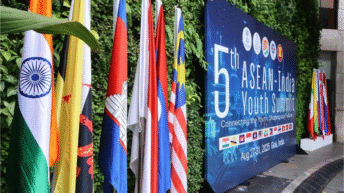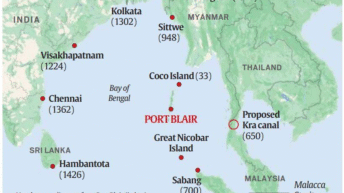|
Listen to article
Getting your Trinity Audio player ready...
|

Reports emerged recently that the Asian Development Bank had decided to finance the upgradation of Main Line-1 (ML-1) of the Pakistan Railways. The 1760 km-long railway corridor connects the passenger- and cargo-intensive routes between Karachi and Peshawar and Havelian and Taxila. The project, which aims to ‘modernise’ Pakistan’s railway network by upgrading and dualising the ML-1, has been at the fulcrum of the USD 62 billion China–Pakistan Economic Corridor. While its cost was initially pegged at USD 6.8 billion, repeated delays and economic instability in Pakistan have escalated it to USD 9 billion.
Until July, despite the delays and escalation in costs, officials from Pakistan’s Railway Ministry and those associated with the CPEC maintained that China would remain the main financer of the ambitious infrastructure connectivity project. Simultaneously, however, a team from the Asian Development Bank, led by its Chief Transport Planner as well as the Pakistan Railways’ Chief Engineer, conducted a feasibility study on the Karachi–Rohri section of ML-1. Last week, the Planning Minister, Ahsan Iqbal announced the constitution of a financing consortium to accelerate the upgradation of ML-1, including the ADB in it.
Consequent to these developments, speculations about the fate of Sino-Pakistani ties have gathered momentum, especially when placed alongside the reset in US–Pakistani relations, spearheaded by the military Establishment. A mutual outreach between Washington DC, and Islamabad, though, does not indicate a corresponding strain in Beijing–Islamabad ties. If anything, as this article discusses, it indicates a reiteration of their iron-clad alliance and its maturation. Pakistan is pursuing a parallel track to reset ties with the West; however, this parallel track is complementary to its relations with Beijing, rather than being in contradiction with it.
ML-1: The Artery of Pakistan Railways
ML-1 constitutes the artery of Pakistan’s railway network. It is one of the 5 main lines of that network, connecting major urban centres on high-capacity, high-speed routes. The ML-1, connecting Karachi to Peshawar, passes through Pakistan’s largest cities, viz. Lahore, Rawalpindi, Multan, and Hyderabad. It not only links the North and South but also Port Qasim and the Karachi Port—which together handle over 90% of Pakistan’s external trade—to the industrial and agricultural hinterland of Punjab and Sindh. ML-1 can handle more than 75% of the passenger and freight traffic across the nearly 90 railway stations it connects.
ML-1’s upgradation and dualisation envisages the refurbishing of existing bridges, whose fragility has unsettled railway officials and citizens since the Khanewal bridge collapse in June. The plan aims to increase the speed of passenger trains to 165 km/h, reducing the distance between Karachi and Peshawar to 17 hours and rendering the transport of perishable commodities feasible. In addition, the creation of a dry port in Havelian will allow economic integration of the Hazara division of Khyber-Pakhtunkhwa with the CPEC.
CPEC’s Travails
The CPEC is critical to linking the land and maritime corridors of the BRI, while the ML-1 is essential to ensure the uninterrupted movement of goods and people across Pakistan, binding the corridors together. Irrespective of those fact, ML-1 typifies the procedural delays and cost escalations that have plagued the implementation of the BRI, its promise notwithstanding. The 6th Joint Cooperation Committee declared the project of ‘strategic’ importance, while the framework agreement was inked in 2017. However, like other CPEC projects in the country, it faced delays in the late 2010s and was rocked by Pakistan’s economic meltdown in the aftermath of the pandemic; the Executive Committee of the National Economic Council approved it only in 2020, after the Imran Khan administration had faced criticism from several corners for its unstable policy on the CPEC. After modifications, the ECNEC approved the 1st phase of the ML-1 last year.
ML-1’s financing structures have undergone several shifts, and its current iteration, rather than dealing a blow to Sino-Pakistani cooperation, reaffirms it. Although no longer the sole funder, China continues to be a critical member of the financing consortium, which includes the ADB and also the Chinese government, as well as the Asian Infrastructure Investment Bank, touted as a parallel to the West-led international financial institutions. Curiously, the modalities and structuring of finance have not been released yet; once they are, they will offer a clearer picture of China’s restructured commitments.
ML-1’s travails mirror the problems in financing of CPEC. The Gwadar Power Plant, for example, despite being pegged for the fast-track, has hit an impasse, due to a mix of security challenges, liquidity crunch, and logistical difficulties in transporting Thar Coal to Gwadar. Similarly, whereas the first phase of most CPEC projects was concluded relatively swiftly, the succeeding phases have hit deadlocks due to shifting priorities of the Chinese and policy misdirection of the Pakistanis. Imran Khan’s PTI, for instance, had alleged corruption and the consolidation of elite, vested interests, thoroughly opposing BRI while in Opposition; it changed its tune only in 2020-21 to steady Pakistan’s rocky fiscal position. Attacks on Chinese workers and frequent requests for debt roll-overs have adversely impacted the monetisation of the CPEC and the relocation of Chinese factories to Pakistan, crucial to the functioning of the Special Economic Zones (SEZs).
Recalibration, Not Retreat
Having said that, China and Pakistan understand the need to iron out their differences: if CPEC is to be the panacea to Pakistan’s economic woes as the backbone of the BRI. In 2022, the Sharif Administration decided to dissolve the CPEC Authority, created by Khan, bringing CPEC affairs under the Planning Ministry. Not only was the channel of command streamlined, Sharif also ensured that the management of the project would be overseen by Ahsan Iqbal, a Sharif loyalist, noted in Pakistan for his policy-oriented governance.
After several rounds of deliberations, the government has secured Chinese support for the next phase: CPEC 2.0. In Beijing this month, Shehbaz Sharif and Premier Li Qiang announced MoUs worth USD 7 billion and joint ventures over USD 1.5 billion. Whereas CPEC’s first incarnation emphasised industrial development, hard infrastructure such as highways and ports, and connected the North and South, CPEC 2.0 epitomises the evolution in Pakistan and China and the BRI, in general. CPEC 2.0 aims for regional inclusiveness, which is expected to assuage the discontent in Pakistan’s Western frontier; in addition, having extended the CPEC to Afghanistan, the integration of Pakistan’s restive North-West with the country’s mainstream will be critical to ensuring resilient supply chains of minerals and end products.
CPEC 2.0 marks the re-orientation of China’s development diplomacy and treads the re-structuring witnessed in other regions. Based on agriculture, clean energy, information–technology pathways, and healthcare, it complements the latest Pakistani Budget that underscores fintech, export promotion, and sustainability. Its emphasis on electric mobility and solar energy will doubtless tap into and consolidate the near-absolute dominance enjoyed by Chinese enterprises in their supply chains. Furthermore, the renewed focus on clean energy and healthcare is part of a larger paradigm shift noted in Chinese investments since the end of the pandemic, resonating with the needs of the recipients and the Chinese to ‘green the BRI’.
The entry of the ADB into the financing consortium signals a re-calibration of Chinese investment goals. Pakistan’s debt-to-GDP ratio is lopsided, with China being the largest international lender. Both countries recognise that it is in their shared interests for Islamabad to diversify its debt basket and distribute risk. China, partly owing to the slowdown in its economy and partly due to the negative perception around BRI financing in the Global South, has slashed its new investments; new lending in developing countries, which began its retreat from 2020 onwards, has settled at pre-2008 levels. China has moderated its fresh investments in nearly all regions; in South Asia, for instance, China’s investment declined for a second consecutive year. China has, instead, focused on hedging financial risk and extending sustainable debts, reflected in more through due diligence and reduction in deal sizes.
The consortium for ML-1 comes against the backdrop of Pakistan’s reset with the West, particularly with the US and EU. The ADB has agreed to finance the modernisation of Pakistan’s power transmission, along with supporting fiscal consolidation. Upgrading the Karachi–Rohri section of the ML-1 will serve American interests in Pakistan’s mineral wealth: The US has already committed USD 500 million toward developing critical mineral supply chains originating in Pakistan to limit the dependence on China. The US and Canada are interested in fostering Balochistan’s rail connectivity to transport copper and gold from the Reqo Diq mines, for which the integration of ML-3 and ML-1 is paramount.
In conclusion, the evolution of ML-1’s financing highlights not a weakening of Sino-Pakistani ties but China’s continued primacy in shaping Pakistan’s infrastructure and economic future. The financing consortium diversifies risk and reduces Islamabad and Beijing’s exposure to unsustainable debts, as recipients and lenders respectively. Reports suggesting that China’s approval to expanding the financing consortium was seminal to these developments hint at a maturation of bilateral ties between China and Pakistan. As the CPEC 2.0 takes shape, ML-1 stands as the backbone of Pakistan’s internal connectivity and confirms China’s enduring position as the main engine of that nation’s development trajectory.






Add comment